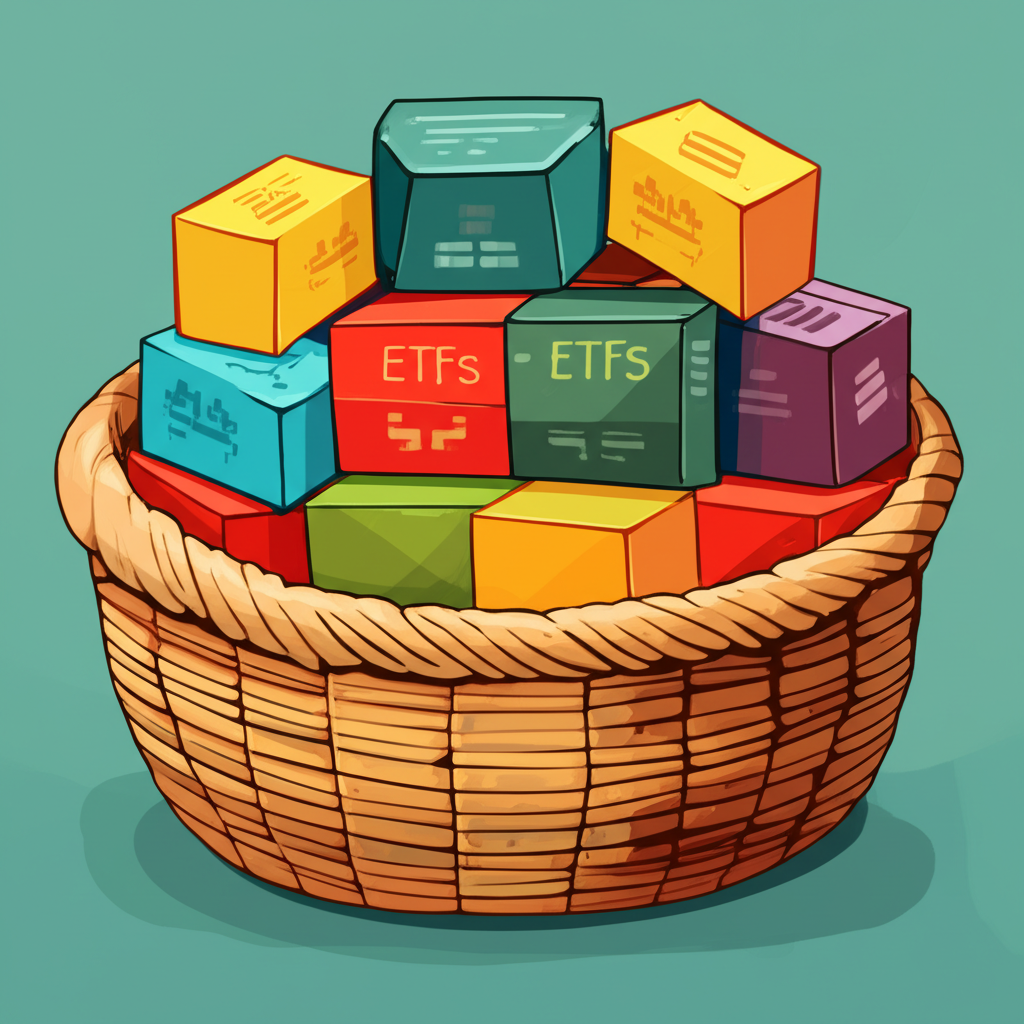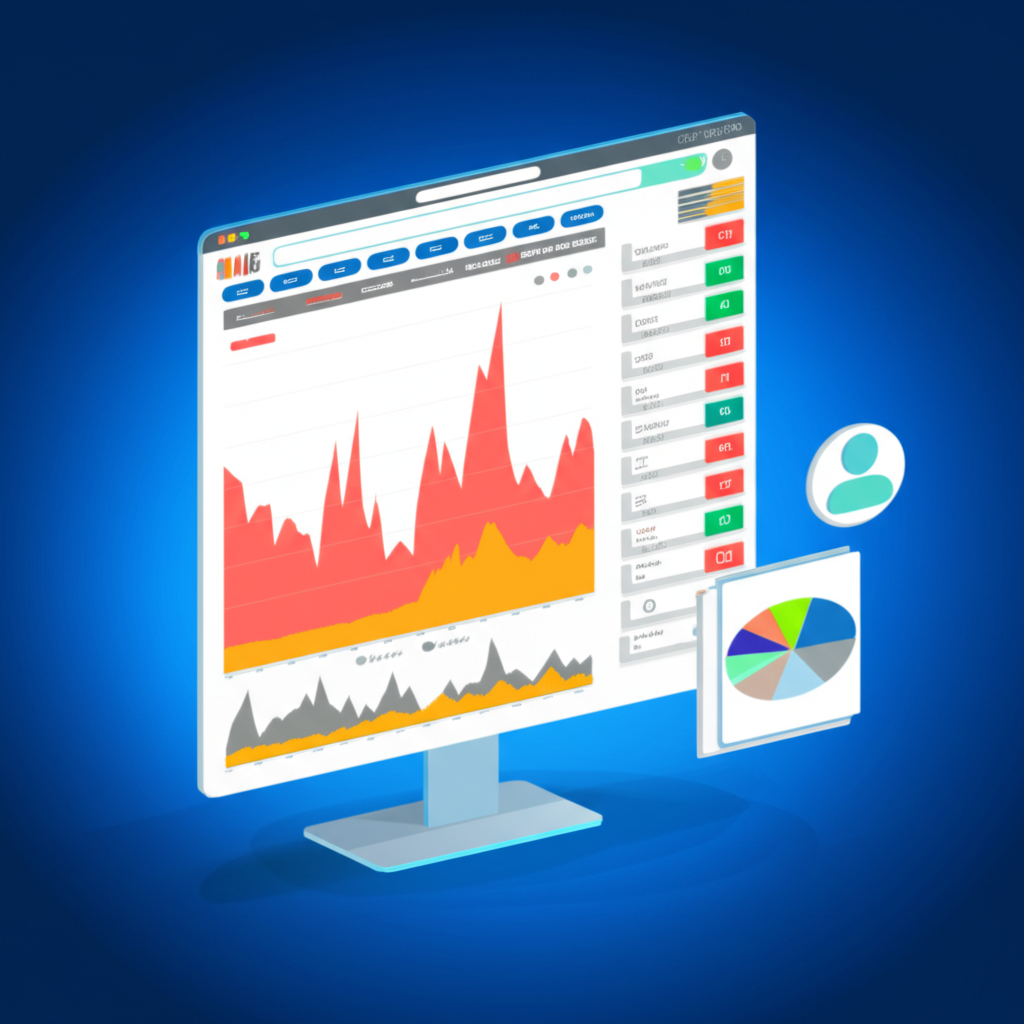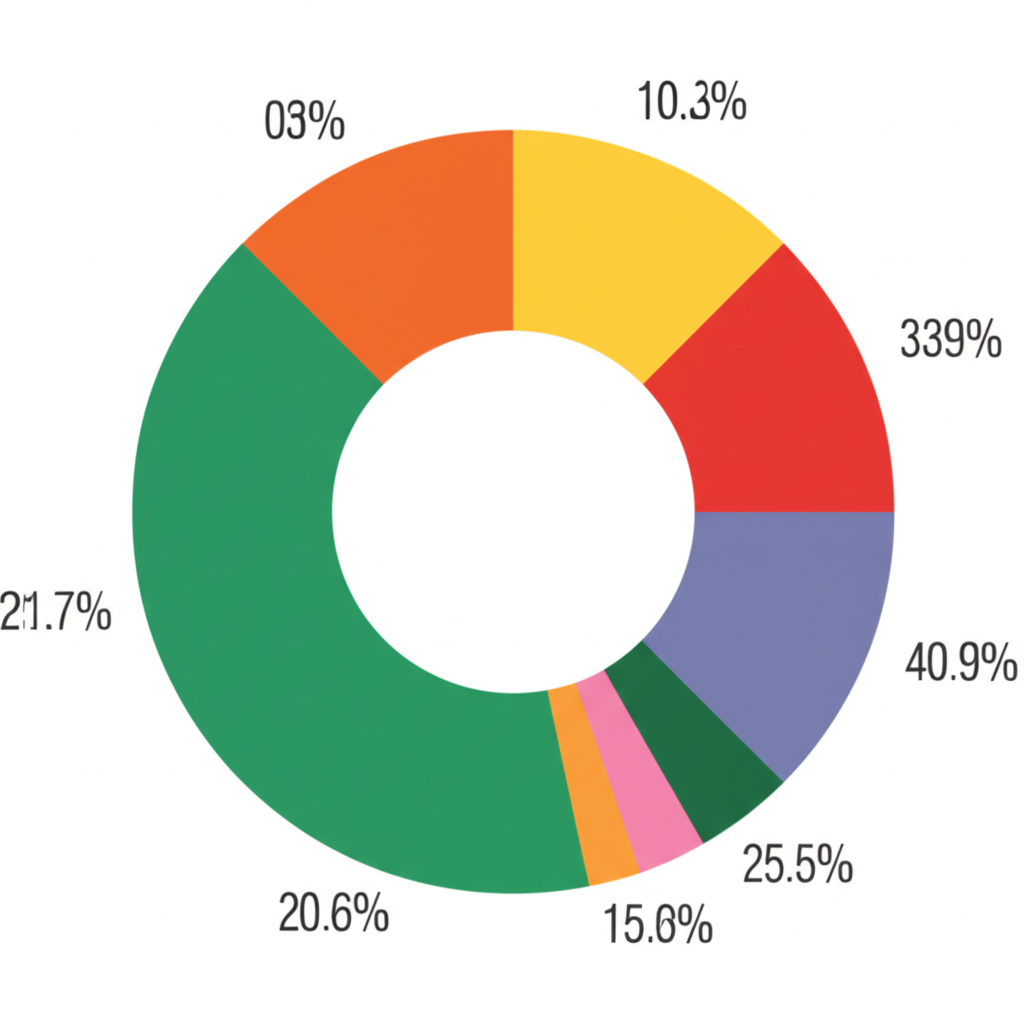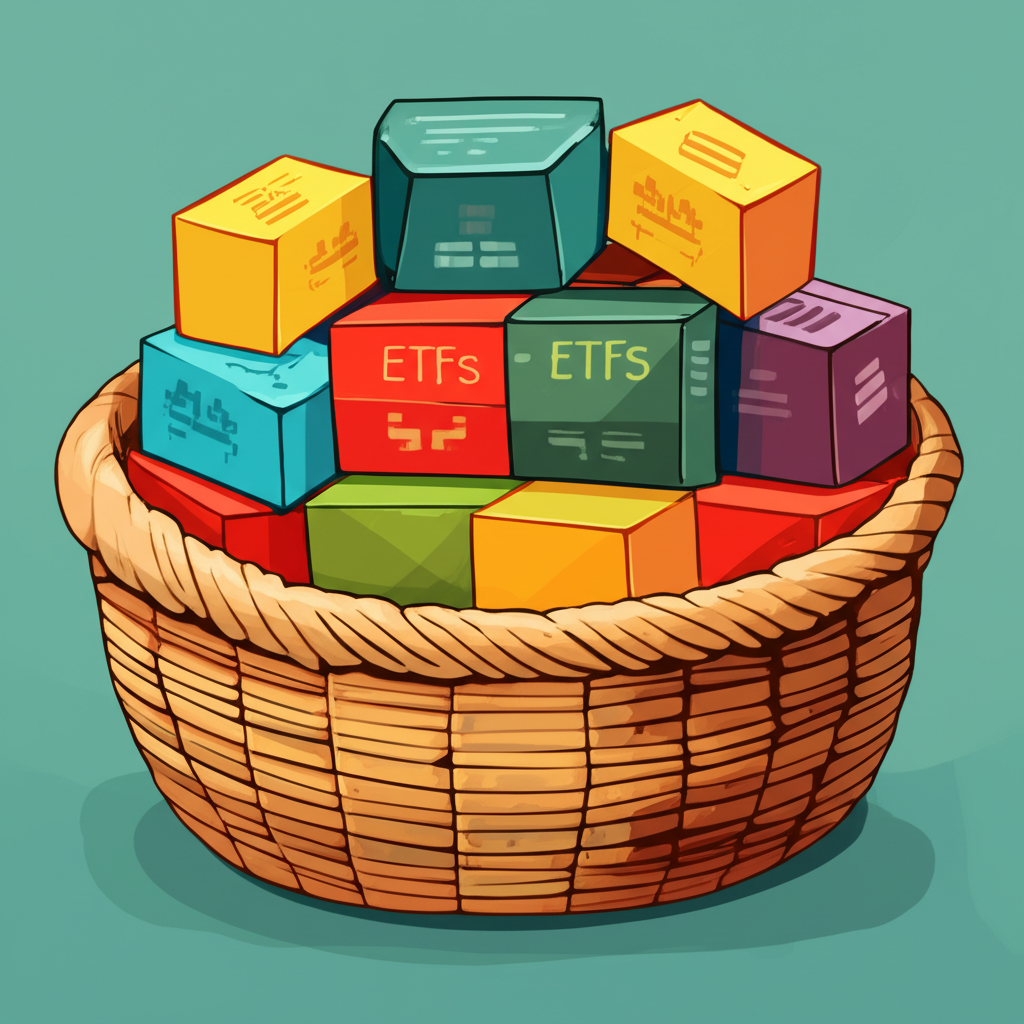Understanding ETFs: Your Gateway to Diverse and Cost-Effective Investing
Have you ever wanted to invest in a wide range of companies or assets without buying each one individually? Or perhaps you’ve heard about investment funds but found them too complicated or expensive? That’s where **Exchange-Traded Funds (ETFs)** come into play, revolutionizing how everyday people, like you and me, can build a robust investment portfolio.
An ETF, short for **Exchange-Traded Fund**, is essentially a basket of various assets—like stocks, bonds, or even commodities and cryptocurrencies—that trades on a stock exchange, much like a regular stock. Think of it like this: instead of buying one apple, one orange, and one banana, you buy a fruit basket that contains all of them. This means when you buy just one unit of an ETF, you’re instantly gaining exposure to all the underlying assets within that basket. This offers immediate **diversification**, a fancy word for spreading your investments around to reduce risk, which is one of the biggest benefits of ETFs.

ETFs offer several compelling advantages that make them a popular choice for investors of all experience levels. These benefits contribute to a more efficient and accessible investment journey.
- Instant diversification across various assets or market sectors with a single purchase.
- Lower expense ratios compared to many traditional mutual funds, leading to greater long-term returns.
- High liquidity, allowing for easy buying and selling throughout the trading day.
- Transparency in holdings, as the underlying assets are typically disclosed daily.
- Accessibility to a wide range of markets and asset classes, including niche sectors and commodities.
Compared to traditional **mutual funds**, ETFs generally boast **lower expense ratios**, which are the annual fees charged by the fund managers. This makes them a more cost-efficient choice for building a long-term investment strategy. We’ll dive deeper into costs later, but for now, know that lower fees mean more of your money stays invested and works for you. The Canadian market, for instance, offers a vibrant landscape with nearly 800 ETFs, showcasing their growing popularity and accessibility.
To further illustrate the differences and help you decide which investment vehicle might be best for your goals, here is a comparison between Exchange-Traded Funds and traditional Mutual Funds:
| Feature | Exchange-Traded Fund (ETF) | Traditional Mutual Fund |
|---|---|---|
| Trading | Trades like a stock on an exchange throughout the day. | Traded once a day after market close at Net Asset Value (NAV). |
| Pricing | Market price fluctuates throughout the day. | Priced once daily based on NAV. |
| Expense Ratios | Generally lower. | Generally higher. |
| Transparency | Holdings usually disclosed daily. | Holdings often disclosed quarterly. |
| Fees | Brokerage commissions (if applicable), bid-ask spread, expense ratio. | Expense ratio, sales loads (front-end or back-end), trading costs within fund. |
| Management Style | Often passively managed (index-tracking), but active ETFs exist. | Typically actively managed, aiming to beat a benchmark. |
ETFs come in many flavors. You’ll find **passively managed index-tracking ETFs** that aim to simply mirror the performance of a specific market index, like the famous **S&P 500** (tracking 500 large U.S. companies) or the **S&P/TSX Composite Index** (tracking the Canadian market). Then there are **sector-specific ETFs** that focus on particular industries, such as technology or oil & gas. For those looking for income, **bond ETFs** are popular, and recent innovations even include **Bitcoin ETFs** and **Ethereum ETFs** in Canada, allowing you to invest in cryptocurrencies through a regulated financial product.
To help you navigate the diverse world of ETFs, here’s a brief overview of some common types and their primary focus:
| ETF Type | Primary Focus | Example Assets |
|---|---|---|
| Index-Tracking ETFs | Mirror the performance of a specific market index. | S&P 500, S&P/TSX Composite Index, NASDAQ 100 |
| Sector ETFs | Invest in companies within a particular industry. | Technology, Healthcare, Energy, Financials |
| Bond ETFs | Provide exposure to various types of bonds for income and stability. | Government bonds, Corporate bonds, High-yield bonds |
| Commodity ETFs | Track the price of physical commodities or commodity futures. | Gold, Silver, Oil, Agricultural products |
| Cryptocurrency ETFs | Offer regulated exposure to digital assets. | Bitcoin, Ethereum |
| Actively Managed ETFs | Fund managers aim to outperform a benchmark by actively selecting holdings. | Various stocks, bonds, or other assets chosen by managers. |
| Factor-Based ETFs | Target specific investment characteristics (factors) to enhance returns. | Value, Momentum, Low Volatility, Quality |
Beyond these, there are also **actively managed ETFs**, where fund managers try to pick winners to beat the market, and **factor-based ETFs** that target specific investment characteristics like “value” or “momentum.” Some, like **covered call ETFs** offered by providers such as Harvest Portfolios Group Inc., are designed to provide enhanced income, though they often come with increased risk and higher management fees. The variety means there’s likely an ETF out there for almost any investment goal you can imagine.
The Art of Selection: Key Factors for Choosing the Right ETF
With so many ETFs available, how do you pick the right ones for your portfolio? It’s like choosing the right tools for a specific job – you need to know what to look for. Here, we’ll break down the crucial criteria that every smart investor considers when selecting ETFs.
When evaluating potential ETFs, a systematic approach considering several key factors can significantly improve your selection process. Focusing on these elements helps ensure your chosen funds align with your financial objectives.
- **Costs:** Prioritize low expense ratios and minimal trading costs.
- **Tracking Performance:** Look for ETFs with low tracking error relative to their benchmark.
- **Fund Characteristics:** Favor reputable providers, larger AUM, and an established track record.
- **Underlying Assets:** Ensure the ETF’s holdings align with your investment goals and risk tolerance.
- **Liquidity:** Understand the liquidity of both the ETF and its underlying assets for efficient trading.
The first thing on your checklist should always be **costs**. The **expense ratio** is the annual fee you pay, expressed as a percentage of your investment. We recommend prioritizing ETFs with low expense ratios, ideally under 0.5%. Why? Because even small fees can eat into your returns significantly over time. For example, a 1% difference in fees can translate to tens of thousands of dollars less in your retirement fund over decades. Beyond expense ratios, remember to consider any **trading commissions** your brokerage might charge and the **bid-ask spread**, which is the difference between the highest price a buyer is willing to pay (bid) and the lowest price a seller is willing to accept (ask). A tighter spread means lower trading costs for you.
Next, let’s talk about **tracking performance** and **tracking error**. If an ETF aims to track the S&P 500, how well does it actually do that? **Tracking error** measures how much an ETF’s performance deviates from its benchmark index. You want an ETF with minimal tracking error, ensuring that your investment closely mirrors the performance of the index it’s supposed to follow. Tools like Morningstar can help you evaluate this.
Consider the **fund characteristics**. We suggest favoring ETFs from **reputable fund providers** like Vanguard, BlackRock (which offers iShares ETFs), or State Street (known for SPDR ETFs). These providers typically have vast resources and a long history of managing funds reliably. Look for ETFs with a larger **fund size**, usually over $100 million in **Assets Under Management (AUM)**. Larger funds often have better liquidity and are less likely to close down, offering more stability for your investment. An **established track record** of at least 3-5 years also gives you a better sense of how the fund performs over different market conditions.
To summarize the essential metrics for ETF selection and provide a quick reference, consider the following:
| Selection Metric | Why it Matters | Ideal Characteristic |
|---|---|---|
| Expense Ratio (ER) | Directly impacts your net returns over time. | Low (e.g., < 0.5%) |
| Tracking Error | Indicates how closely the ETF follows its benchmark. | Minimal |
| Assets Under Management (AUM) | Suggests liquidity and fund stability. | Large (e.g., > $100M) |
| Track Record | Provides insight into performance across market conditions. | Established (e.g., 3-5+ years) |
| Bid-Ask Spread | Affects trading costs, especially for frequent traders. | Tight |
| Underlying Holdings | Ensures alignment with investment goals and desired exposure. | Transparent and relevant |
| Fund Provider Reputation | Indicates reliability and resources supporting the fund. | Well-established and trusted |
You also need to understand the **underlying index or assets** the ETF tracks. Does it align with your investment goals? Are you looking for exposure to the broad U.S. market, specific sectors like technology, or perhaps international markets such as Emerging Markets? For income-focused strategies, you might consider **dividend-distributing ETFs**, which pay out regular income from the dividends of their underlying stocks. A clear definition of your investment goals and **risk tolerance** is paramount, as it guides your choices from geography to sectors and then to specific funds.
Strategic Investing: Tailoring ETFs to Your Financial Goals
Investing isn’t just about picking individual funds; it’s about building a coherent strategy that aligns with your personal financial goals and how much risk you’re comfortable taking. Think of it as constructing a building: you need a solid blueprint before you lay the first brick. ETFs offer immense flexibility for various **investment strategies**.
When developing your investment strategy with ETFs, consider these core principles to maximize your chances of success and align with your personal financial objectives:
- **Define Your Goals:** Clearly identify what you are saving or investing for (e.g., retirement, down payment, child’s education).
- **Assess Risk Tolerance:** Understand how much market volatility you can comfortably endure without panicking.
- **Time Horizon:** Determine how long you plan to invest, as this influences asset allocation.
- **Diversify:** Spread investments across different asset classes, sectors, and geographies.
- **Keep Costs Low:** Prioritize ETFs with low expense ratios to preserve returns.
- **Regularly Review:** Periodically check your portfolio and rebalance if necessary to stay aligned with your strategy.
For many, especially beginners, **passive investing** is a highly recommended approach. This strategy involves replicating a broad market index, such as the S&P 500, rather than trying to outperform it. The idea, championed by investment legends like Warren Buffett who recommends low-cost S&P 500 index funds, is that over the long term, the market tends to go up. Broad ETFs like Vanguard’s VEQT (a Canadian all-in-one equity ETF) are excellent examples, offering wide market exposure with built-in diversification. This approach is generally recommended for beginners due to its simplicity, diversification, and stability.
On the other hand, **active investing** aims to outperform a benchmark index through skilled stock picking or market timing. While some actively managed ETFs exist, they often come with higher fees, and historically, many struggle to consistently beat their benchmarks after expenses. A more nuanced approach is **rules-based or factor-based investing**, which targets specific characteristics proven to drive returns, such as “value” (undervalued companies) or “momentum” (stocks with recent strong performance). These are often implemented through specialized factor-based ETFs.
A fundamental principle in successful investing is **diversification**. Nobel laureate Harry Markowitz famously called diversification “the only free lunch” in investing. It means spreading your investments across different asset classes (stocks, bonds, real estate, commodities), sectors (technology, healthcare, energy), and geographies (Canada, U.S., Europe, Emerging Markets). Broadly diversified ETFs make this incredibly easy. For instance, instead of putting all your eggs in one country’s basket, you might use a combination of Canadian (e.g., VCN for Canadian equities) and international (e.g., VXC for global ex-Canada equities) ETFs.
You can also adopt a **core-and-explore approach**. Here, the “core” of your portfolio consists of broad, passively managed ETFs for stable, diversified exposure. The “explore” portion might be a smaller percentage dedicated to more narrow or thematic ETFs, perhaps focusing on a high-growth sector you believe in, like clean energy or specific emerging markets like India or China. This allows you to potentially capture higher returns from specific trends while maintaining a solid foundation. Remember, your chosen strategy should always align with your **risk tolerance**—how much volatility you can stomach—and your long-term **investment goals**.
Executing Trades: Practical Steps and Avoiding Common Pitfalls
Once you’ve decided which ETFs fit your investment strategy, the next step is to actually buy them. This might seem daunting at first, but with a few practical steps and awareness of common pitfalls, you’ll be trading like a pro in no time.
First, you’ll need to **open a discount brokerage account**. Platforms like **Questrade** or **Wealthsimple Trade** are popular choices in Canada, offering low-cost or even commission-free trading for ETFs. Funding your account is usually straightforward, typically through bank transfers. Once your account is set up and funded, you can start your research to determine the specific ETF(s) to purchase based on your investment goals and the selection criteria we discussed earlier.
When you’re ready to buy, you’ll see two important prices: the **bid price** (the highest price buyers are willing to pay) and the **ask price** (the lowest price sellers are willing to accept). The difference between these is the **bid-ask spread**. You’ll also need to calculate the number of shares you can afford based on your available funds. Here’s a crucial tip: always use **limit orders** instead of market orders, especially for less liquid ETFs. A **market order** tells your broker to buy or sell at the best available price immediately, which can sometimes lead to unexpected or unfavorable prices, especially if the market is volatile. A **limit order**, however, allows you to specify the maximum price you’re willing to pay or the minimum price you’re willing to sell at, giving you much more control over your purchase price.

It’s generally best to **trade during market hours**, for example, between 9:30 am and 4:00 pm ET for North American markets. Trading outside these hours can result in wider bid-ask spreads, less liquidity, and potentially delayed order fulfillment, leading to less reliable prices. Immediate order fulfillment is more likely when the market is fully active.
Now, let’s talk about some **common pitfalls** to avoid:
- Overlapping Holdings: Don’t hold multiple ETFs that track the exact same index or country unnecessarily. This adds complexity without increasing diversification and can lead to unintended concentration. Tools like Fund Overlap can help you identify shared holdings.
- High Fees from Frequent Trading: If you’re using a broker that charges commissions for every trade, frequent buying and selling can quickly erode your returns. Stick to commission-free platforms for ETFs or consider all-in-one asset allocation ETFs that require minimal rebalancing.
- Overcomplicating Your Portfolio: For beginners, simplicity is key. All-in-one asset allocation ETFs (like Vanguard’s VEQT or VBAL) automatically diversify and rebalance for you, making portfolio management incredibly easy. Don’t feel pressured to pick dozens of individual ETFs.
- Intimidation by Self-Directed Investing: If managing your own investments feels daunting, don’t worry! **Robo-advisors** are automated investment platforms that build and manage a diversified ETF portfolio for you based on your risk tolerance, for a low fee. They handle rebalancing and often provide tax-efficient strategies.
- Focusing on ETF Price vs. NAV: The unit price of an ETF isn’t as important as its **Net Asset Value (NAV)** and its total return performance. A cheaper ETF unit price doesn’t necessarily mean it’s a better value.
- Misunderstanding Liquidity: While an ETF’s trading volume on the exchange is a factor, true ETF liquidity is primarily driven by the **liquidity of its underlying assets**. This is a crucial distinction: even if an ETF has low trading volume, if its underlying stocks or bonds are highly liquid, you can still buy and sell the ETF without significant price impact.
Advanced Analysis for the DIY Investor: Tools and Techniques
For those of you who enjoy digging deeper and want to take your ETF selection to the next level, there are powerful **advanced research tools** available. These platforms empower **DIY investors** to perform thorough due diligence and make highly informed decisions, moving beyond basic expense ratios and fund sizes.

One such tool is the **Alpha Architect Fund Screener**. This platform is excellent for analyzing ETFs based on factors like **market cap** (the total value of a company’s outstanding shares) and **position size**, helping you identify ETFs with specific factor tilts such as value, momentum, or small-cap exposure. Understanding these factor profiles can help you tailor your portfolio to specific investment characteristics you believe will outperform.
**Morningstar** is another invaluable resource. It provides comprehensive data, including an ETF’s **stock style** (e.g., growth vs. value, large-cap vs. small-cap), **factor profile**, and detailed **sector and country exposure**. This allows you to see exactly what you’re investing in and ensure it aligns with your desired diversification and strategic allocation. For instance, you can use Morningstar to compare the sector breakdown of two technology ETFs to avoid unintended overlaps or concentrations.
To evaluate how different ETFs or portfolio combinations might have performed historically, **Portfolio Visualizer** is an excellent choice. This tool allows you to compare the performance, risk, and asset allocation of various funds over different time periods. You can input multiple ETFs and see how a hypothetical portfolio would have grown, helping you stress-test your investment choices and understand potential returns and volatility.
Finally, to prevent the common pitfall of overlapping holdings, a **Fund Overlap** tool is incredibly useful. This type of tool helps you identify if different ETFs in your portfolio are investing in the same underlying stocks or bonds. By minimizing unnecessary overlaps, you ensure your diversification efforts are truly effective and that you’re not paying multiple fees for the same exposure. For example, if you hold both a broad U.S. market ETF and a U.S. large-cap ETF, a fund overlap tool can show you the extent of their shared holdings.
These tools, when used effectively, can transform your investment process. They allow you to move from simply accepting what’s available to actively constructing a portfolio that is precisely aligned with your financial objectives, risk tolerance, and desired factor exposures. Remember, continuous learning and leveraging these resources are key to becoming a confident and successful DIY investor.
Conclusion: Empowering Your Investment Journey with ETFs

We’ve covered a lot of ground today, from understanding what **Exchange-Traded Funds (ETFs)** are to strategically selecting them, executing trades, and even diving into advanced analytical tools. ETFs truly represent a powerful and accessible pathway to building a **diversified and cost-effective investment portfolio**.
By grasping their core characteristics – like instant diversification and generally lower **expense ratios** compared to traditional **mutual funds** – you can confidently navigate the investment landscape. Prioritizing factors such as minimal **tracking error**, strong **liquidity**, and reputable **fund providers** will help maximize your long-term **returns**. Remember the importance of **diversification**, as advocated by Harry Markowitz, as it remains the “only free lunch” in investing.
Whether you choose a simple all-in-one ETF or construct a more nuanced portfolio using **factor-based ETFs** and advanced research, the key lies in making informed decisions that align with your individual financial aspirations. Don’t be afraid to leverage **discount brokerages** and analytical tools like **Morningstar** or **Portfolio Visualizer** to empower your journey. Your investment success starts with understanding, planning, and consistent, disciplined action.
Disclaimer: This article is intended for educational and informational purposes only and does not constitute financial advice. Investing involves risks, including the potential loss of principal. Always consult with a qualified financial professional before making any investment decisions. The specific companies, platforms, and ETFs mentioned are examples for illustrative purposes only and not recommendations.
Investing in ETFs can be a straightforward and rewarding experience when approached with a clear understanding of their mechanics and potential. Many common questions arise for new and experienced investors alike, and addressing these can further demystify the process.
常見問題(FAQ)
Q:What is the main difference between an ETF and a mutual fund?
A:ETFs trade like stocks on an exchange throughout the day with fluctuating market prices, generally have lower expense ratios, and offer daily transparency of holdings. Mutual funds are typically traded once a day after market close at their Net Asset Value (NAV) and often come with higher expense ratios and less frequent disclosure of holdings.
Q:How can I minimize fees when investing in ETFs?
A:To minimize fees, prioritize ETFs with very low expense ratios (ideally under 0.5%), use discount brokerages that offer commission-free ETF trading, and employ limit orders to control your purchase price and avoid unfavorable bid-ask spreads. For long-term investors, consider all-in-one asset allocation ETFs to reduce the need for frequent rebalancing and associated trading costs.
Q:Are ETFs suitable for beginner investors?
A:Yes, ETFs are highly suitable for beginner investors due to their simplicity, built-in diversification, and cost-effectiveness. All-in-one asset allocation ETFs are particularly recommended as they automatically manage asset allocation and rebalancing, requiring minimal effort from the investor. If self-directed investing feels daunting, robo-advisors can manage an ETF portfolio for you.



No responses yet